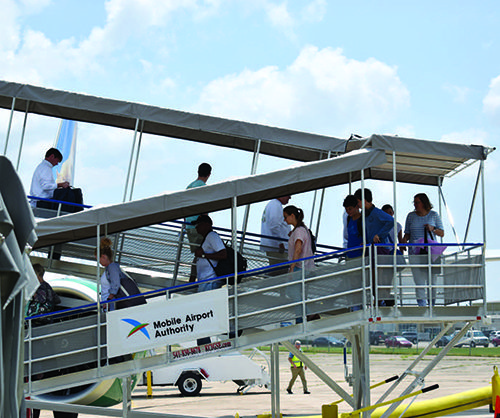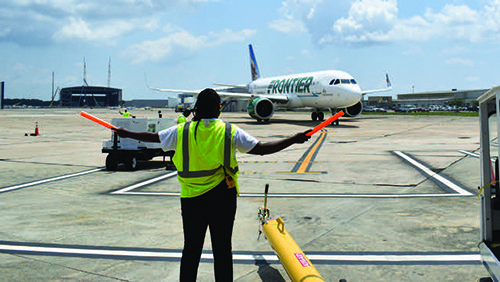When the Mobile Airport Authority gave the go-ahead to begin moving commercial operations from Mobile Regional Airport (MOB) to Mobile Downtown Airport (BFM), it then had to build a terminal and find a way to provide ground support at what was strictly a general aviation facility.
When the Mobile Airport Authority gave the go-ahead to begin moving commercial operations from Mobile Regional Airport (MOB) to Mobile Downtown Airport (BFM), it then had to build a terminal and find a way to provide ground support at what was strictly a general aviation facility.
Fortunately, the runways and other key infrastructure were already in place because BFM is located within the authority-owned Mobile Aeroplex at Brookley. Airbus, another tenant, manufactures A320s, A321s and A220s at the air industrial complex.
The airport authority is moving scheduled airline service from MOB to BFM to make air travel easier and more accessible for residents living in the city’s fast-growing suburbs. (BFM is closer and has better interstate and highway access than MOB.) Authority President Chris Curry says Mobile is currently losing too much business to neighboring airports in Pensacola, FL, and New Orleans.
|
Project: New Terminal Location: Mobile (AL) Downtown Airport Owner: Mobile Airport Authority Cost: $8 million ($5 million for building renovations; $3 million for security enhancements) Funding: Self-financed Strategy: Renovate warehouse into commercial service terminal Carrier: Frontier Airlines Terminal Features: 5 ticket counters; 2 hold areas; 3 rental car counters; 1 TSA security line; ramp space for two A320s & 1 regional jet; mobile boarding stairs/ramp; new pubic parking area & vehicle turn lanes Renovation Timeline: Fall 2018 to late April 2019 Relocation Feasibility Consultant: VHB Master Plan Consultant: Leigh Fisher/Jacobs Terminal Architect & Interior Designer: KPS Group Inc. Space Programmer: Jacobsen/Daniels Construction Manager at Risk: JESCO Inc. Structural, Mechanical, Plumbing: AVCON Inc. Electrical: Humber-Garick Consulting Engineers Boarding Ramp: Keith Consolidated Industries Other Investment: $425,000 for ground support equipment Strategy: Save money by using in-house crews & equipment for ground handling service vs. hiring third-party provider |
(For more background about the decision and strategy to move service, check out our November/December 2018 issue at airportimprovement.com.)
The airport authority selected a 50,000-square-foot warehouse for BFM’s new commercial terminal. Airbus had been using the Foreign Trade Zone facility to sort parts it imports to build A320s. Initially, only 22,000 square feet of the warehouse will be used for the terminal, but that number will grow as traffic grows.
The airport authority established strict project deadlines to prepare the facility in time for Frontier Airlines to begin service from BFM to Denver and Chicago in May.
Originally, Via Airlines was going to be the launch carrier, with initial service at MOB transitioning to BFM once the terminal was ready. However, Via ceased service from Mobile last summer.
Challenge Accepted
When work on the warehouse began last fall, Mobile Airport Authority had 160 days to renovate the structure and secure necessary approvals from TSA.
In October 2018, it retained the Birmingham, AL, office of KPS Group to design the building. In turn, KPS retained JacobsenDaniels to assist in creating a building program. The firms provided a plan to authority officials within two weeks of getting the assignment, notes KPS senior principal Gray Plosser.
Due to the tight deadlines, a traditional contractor bidding route was not appropriate, he explains. Instead, the firm assisted the airport authority in hiring its first construction manager: JESCO Inc.
“The challenge was how to make a silk purse out of a sow’s ear,” Plosser recalls. “It was just a big old metal warehouse building.” KPS was charged with creating a terminal to accommodate near-term traffic: five A320 flights a week.
The completed terminal has five ticket counters, two hold areas with gate check-in positions, three rental car counters and one TSA security line. There is parking space on the ramp for two A320s and one regional jet. Rather than installing jet bridges, the airport is using mobile boarding stairs/ramps that are compliant with the Americans with Disabilities Act.
Demolition work began in early January while the airport authority awaited final building permits, explains Brian Slaughter, JESCO’s senior project manager. Crews removed exterior metal siding and three loading docks. Inside, a firewall was built down the middle of the open building to separate the new terminal from space Airbus will to continue to use.
“The structure was never intended to be a ‘people building.’ It was an alien thing for its new use,” Plosser observes.
Contractors replaced the overhead roll-up doors with storefront windows and doors that allow natural light into the interior, and added insulation on the exterior walls and roof. Spaces for the ticket counters, restrooms and TSA area were prepared; and the warehouse’s high ceilings and exposed ductwork were maintained for the entrance area and in holdrooms.
Plosser compares the project to a performing a tenant build-out in an existing building while simultaneously having to upgrade its exterior envelope.
JESCO crews worked 10-hour days, seven days a week for about two-thirds of the project, Slaughter reports.
The biggest challenge was erecting a new steel canopy on the front side of the building. Obtaining the desired steel roofing panels in short order was difficult, he notes.
The fast turnaround also caused headaches in procuring equipment needed for the baggage handling system and backup generators, add KPS Project Manager Jasper Cornett.
The schedule also dictated some of the terminal’s interior finishes, as there was not enough lead time to order imported marble or other high-end materials.
New Service, New Needs
While contractors transformed the physical structure, personnel from the airport authority worked with TSA on a security plan for the new terminal. Because Airbus would continue using part of the building, it was important to keep that portion isolated from the airfield.
At TSA’s direction, BFM was equipped with a baggage screening area and a single-lane passenger checkpoint that can be expanded to accommodate a second lane if needed. Team members note that cooperation and support from TSA were essential in achieving the abbreviated schedule.
The airport authority spent $5 million transforming the warehouse into a terminal, and another $3 million to add perimeter fencing, surveillance cameras and other security features needed to support commercial airline operations.
The authority financed the project with cash on hand.
Landside improvements include a new public parking area across the street from the terminal and new turn lanes on Michigan Avenue to separate terminal traffic from Aeroplex traffic.
Construction crews completed the bulk of their work on April 24, and TSA approved the security plan on April 29. As scheduled, the first Frontier flight arrived on May 1.
BFM’s terminal was specifically designed to serve low-cost airlines like Frontier rather than legacy carriers, explains Plosser. “Our charge was to deliver the biggest bang for the buck,” he says. “Our job was to produce something that would exceed the expectations of the airport authority, and we think we did that.”
“It looks like a finished terminal,” Curry observes. “It is not an elaborate structure. You will see some carpeted surfaces and a of lot concrete. It has exposed ductwork and was built to transition people through as quickly as possible with the least amount of expense to passengers and the airline.”
The only concessions in the terminal are vending machines, which are located before and after the TSA checkpoint.
Curry does not expect to add service to BFM from American Airlines, Delta Air Airlines or United Airlines anytime soon. “The brand of the legacy carriers is different from the low-cost carrier,” he explains. “They want a structure with more amenities. We do not use jet bridges at this time, and that is something that is important to the legacy carriers. They are better suited to make the transition once we build another facility.”

Toward that end, Leigh Fisher/Jacobs is creating a 20-year master plan outlining what additional buildings will be needed to complete the shift from MOB to BFM. The firm anticipates completing the plan in June 2020.
Phased Expansion
In the meantime, work to expand BFM’s new terminal into the rest of the warehouse is expected to begin before the end of this year. The additional space will accommodate two more gates and holdrooms, and a larger luggage screening area.
 The expansion is not contingent on securing another carrier or more Frontier flights, specifies Curry. The current terminal was designed so existing operations will not be disrupted when the rest of the building is being converted, Plosser adds.
The expansion is not contingent on securing another carrier or more Frontier flights, specifies Curry. The current terminal was designed so existing operations will not be disrupted when the rest of the building is being converted, Plosser adds.
The new capacity at BFM will be about 10 A320 flights per day. By comparison, three carriers at MOB currently fly 23 flights a day to four hub cities. Fully 80% of those flights are on regional jets.
Costs for carriers are lower at BFM. While a full rates and charges study is currently underway, Curry notes that it costs FedEx $1.98 per 1,000 pounds to land a cargo plane at BFM vs. $2.20 per 1,000 pounds at MOB.
Mobile Airport Authority’s air service incentive program does not favor one airport over the other, Curry advises. In addition to granting a two-year fee waiver and providing above- and below-the-wing ground handling services for flights to new destinations, it also offers $50,000 marketing assistance for the first year and $25,000 the second year. Depending on the destination, community groups may provide additional marketing assistance, he adds.
The airport authority is very active and competitive with airline recruitment, Curry emphasizes. “New carriers are always on the line. It is just a matter if you can pull them out of the water,” he remarks.
Frontier’s arrival brought two new destinations to the Mobile market. The Denver-based carrier is flying three times a week to Denver International and twice a week to Chicago O’Hare.
United stopped flying to its Chicago hub from MOB last October.
When Frontier committed to the Mobile market, the possibility of service to Orlando was highly desirable to the airport authority. The Florida destination is reportedly of keen interest to local residents, and BFM officials continue to discuss the route with Frontier.
“The market has responded extremely well,” reports Curry. In July, flights to Denver were averaging 90% load factors, and Chicago flights were in the mid-80s.
Overall, enplanements have been growing: from 2,600 in May to 3,000 in June and 3,700 in July.

In-House Ground Support
Providing the promised ground handling services for Frontier’s limited flight schedule could have evolved into a “financial nightmare,” Curry relates. Airport personnel suspected that hiring a third-party provider would be costly due to the carrier’s initially intermittent schedule—and responses to a proposal solicitation proved them right.
“We thought we could do this ourselves with the right equipment and right personnel,” he explains. Two factors inspired them to try: the high cost of outsourcing the work and the chance to control the entire customer experience.
 “We worked to make sure we could provide what Frontier required and that we could meet their standards,” explains Izzy Bonilla, vice president of Operations.
“We worked to make sure we could provide what Frontier required and that we could meet their standards,” explains Izzy Bonilla, vice president of Operations.
The airport authority consequently invested about $425,000 in new and used ground support equipment for the carrier’s A320s. “You can hit the used sales and find some relatively new equipment. We just put a new coat of paint on them,” says BFM Station Manager Doug Bullock of the airport’s used belt loaders, bag tugs, luggage carts, ground power and ground air conditioning units.
The airport’s only major piece of new equipment is a boarding ramp purchased from Keith Consolidated Industries. With it in place, BFM can dual load an A320 with a stair truck and the boarding ramp, or simultaneously load two A320s using each plane’s front entryway.
During ground operations, in-house crews vacuum aircraft, perform light cleaning, vacuum and re-stock supplies, soft drinks and ice. Signature Flight Support, the existing fixed-base operator at the Aeroplex, handles fueling.
Nine airport authority employees perform above-wing services and another nine handle below-wing tasks. Some are full-time employees; others work part-time.
 Companies that provide ground services at MOB also employ several of the part-time crewmembers. Bullock notes that the airport authority pays competitive wages to avoid losing staff to the firms at MOB.
Companies that provide ground services at MOB also employ several of the part-time crewmembers. Bullock notes that the airport authority pays competitive wages to avoid losing staff to the firms at MOB.
Although Frontier flies from BFM on Mondays, Wednesdays and Saturdays, the ticket counter is open six days a week so passengers who don’t want to book online can purchase tickets at the airport. Counter personnel are employed by the airport authority, and wear Frontier uniforms on flight days and BFM uniforms the other three days.
Per the airport authority’s incentive program, Frontier is not changed for any of the ground handling services it receives at BFM. “After two years, the carrier will need to determine whether to hire a third-party, do it themselves or hire us. We would like to put ourselves in a position that they will hire us,” says Bullock.
In late July, BFM was tied for first place in a customer satisfaction contest Frontier was conducting. “We have had zero bags lost,” Bullock reports.
After seeing the ground crews in action, an industrial tenant at the Aeroplex approached the airport authority about providing ground handling services for its Airbus operations. Curry also hopes to win ground handling business at MOB from American, Delta and United when their existing contracts with third-party partners expire.


 facts&figures
facts&figures

